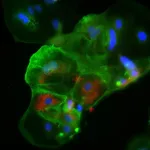(Press-News.org)
Québec, July 13, 2023 – Professor Simona Stäger’s team has made a breakthrough in the study of the human immunodeficiency virus (HIV). The researchers have identified the mechanism by which memory CD4+ T lymphocytes—cells that play a major role in our immune response—are predisposed to cell death in people living with HIV. The team’s findings have just been published in JCI Insight.
In this new study, Professor Stäger and her research team built on work done on mice infected with the Leishmania donovani parasite (published in Cell Reports in 2018), which described how a chronic inflammatory environment predisposes certain cells to cell death. This premise led them to think that such a mechanism could be common to other chronic infectious diseases. They then turned their attention to HIV.
“This is an important discovery, since the cell death mechanism we demonstrated could be involved in other chronic infections like COVID-19 and visceral leishmaniasis in humans.” – Simona Stäger, Professor at INRS and expert in immunology of infectious diseases.
A molecular imprint leading to cell death
In most people living with HIV and undergoing antiretroviral treatment, residual inflammation persists despite some degree of viral control. The memory CD4+ T cells of people undergoing treatment are known to be prone to cell death. However, until today, the underlying mechanism remained largely unknown.
The researchers found that memory CD4+ T cells have a higher expression of the TLR7 receptor and the IRF5 transcription factor, which represents an imprint in these cells—predisposing them to cell death. The results also show that IRF-5 inhibitory peptides can block this predisposition.
The imprint Stäger’s team observed is the consequence of a chronic inflammatory environment. The results of this study could therefore have implications for other chronic infectious diseases characterized by a significant inflammatory environment.
Memory cells: keepers of immunity
Memory cells assist the immune system in protecting itself against a pathogen after an initial encounter with it. This is the basic principle of vaccines, which provoke a memory immune response—and therefore immunity—against an infectious agent. Consequently, the loss of these memory cells is a major risk for anyone suffering from a chronic infection.
In 80% of people living with HIV and receiving treatment, this discovery could help preserve memory cells. For the 20% of individuals in whom treatment remains ineffective, the breakthrough proposed by Professor Stäger’s team could open the door to a more suitable therapy.
Liseth Carmona Perez, a PhD student at INRS, spearheaded the project. Her research interests focus on infectious diseases and T lymphocytes, cells that play a major role in the human immune response. Liseth worked under the supervision of Professor Stäger and was accompanied by three other students: Linh Thuy Mai, Tanja Stögerer, and Sharada Swaminathan at the Armand-Frappier Santé Biotechnologie Research Centre.
“I feel very lucky to be able to work alongside such an incredible research group. I am hoping that our work will not only contribute to the advancement of medical knowledge, but also eventually lead to the development of new therapeutic approaches for managing chronic infectious diseases.” – Liseth Carmona Perez, doctoral student in virology and immunology.
For this publication, Professor Simona Stäger and doctoral student Liseth Carmona Perez collaborated with the laboratory of Dr. Betsy Barnes of the Feinstein Institute for Medical Research in New York, along with leading HIV specialists: Dr. Jean-Pierre Routy of McGill University and his postdoctoral student Stéphane Isnard as well as Julien van Grevenynghe, professor at INRS and Xavier Dagenais-Lussier, his PhD student at the time of the research.
About the paper
The paper “The TLR7-IRF-5 axis sensitizes memory CD4+ T cells to Fas-mediated apoptosis during HIV-1 infection” was published in the JCI Insight, July 2023, (Volume 8, Issue 13) by Liseth Carmona-Perez, Xavier Dagenais-Lussier, Linh T. Mai, Tanja Stögerer, Sharada Swaminathan, Stéphane Isnard, Matthew R. Rice, Betsy J. Barnes, Jean-Pierre Routy, Julien van Grevenynghe, and Simona Stäger.
The team’s work received financial support from the Canadian Institutes of Health Research (CIHR) and the Natural Sciences and Engineering Research Council of Canada (NSERC). Linh Thuy Mai and Tanja Stögerer are recipients of a doctoral fellowship from the Fonds de recherche du Québec – Santé (FRQS).
About INRS
INRS is a university dedicated exclusively to graduate level research and training. Since its creation in 1969, INRS has played an active role in Québec’s economic, social, and cultural development and is ranked first for research intensity in Québec. INRS is made up of four interdisciplinary research and training centres in Québec City, Montréal, Laval, and Varennes, with expertise in strategic sectors: Eau Terre Environnement, Énergie Matériaux Télécommunications, Urbanisation Culture Société, and Armand-Frappier Santé Biotechnologie. The INRS community includes more than 1,500 students, postdoctoral fellows, faculty members, and staff.
-30-
Source :
Julie Robert
INRS Communications and Public Affaires Department
514-971-4747
julie.robert@inrs.ca
Twitter
Facebook
END
RICHMOND, Va. (July 13, 2023) — A new study by a Virginia Commonwealth University researcher has found that aggression is not always the product of poor self-control but, instead, often can be the product of successful self-control in order to inflict greater retribution.
The new paper, “Aggression As Successful Self-Control,” by corresponding author David Chester, Ph.D., an associate professor of social psychology in the Department of Psychology at VCU’s College of Humanities and Sciences, was published by the journal Social and Personality Psychology Compass and uses meta-analysis to summarize evidence from dozens of existing ...
A person’s ‘mindreading ability’ can predict how well they are able to cooperate, even with people they have never met before.
Researchers at the University of Birmingham found that people with strong mind reading abilities – the ability to understand and take the perspective of another person’s feelings and intentions– are more successful in cooperating to complete tasks than people with weaker mind reading abilities.
These qualities, also called ‘theory of mind’, are not necessarily related to intelligence and could be improved through training programmes to foster improved cooperation, for example in ...
Use of low-dose atropine eyedrops (concentration 0.01%) was no better than placebo at slowing myopia (nearsightedness) progression and elongation of the eye among children treated for two years, according to a randomized controlled trial conducted by the Pediatric Eye Disease Investigator Group (PEDIG) and funded by the National Eye Institute (NEI). The trial aimed to identify an effective way to manage this leading and increasingly common cause of refractive error, which can cause serious uncorrectable vision loss later in life. Results from the trial were published in JAMA Ophthalmology.
Importantly, the findings contradict results from recent trials, primarily in East Asia, which ...
About The Study: In this randomized clinical trial of school-age children in the U.S. with low to moderate myopia (nearsightedness), atropine, 0.01%, eye drops administered nightly when compared with placebo did not slow myopia progression or axial elongation. These results do not support use of atropine, 0.01%, eye drops to slow myopia progression or axial elongation in U.S. children.
Authors: Michael X. Repka, M.D., M.B.A., of the Wilmer Eye Institute in Baltimore, is the corresponding author.
To access the embargoed study: Visit our For The Media website at this ...
About The Study: This study provides evidence of the clinical effectiveness of mRNA-based vaccines against COVID-19 in patients with cancer. Longevity of immunity in preventing severe COVID-19 outcomes in actively treated patients with cancer, cancer survivors, and matched controls was observed at least five months after the third or fourth dose.
Authors: Raghav Sundar, M.B.B.S., Ph.D., of the National University Health System in Singapore, and Kelvin Bryan Tan, Ph.D., of the Ministry of Health in Singapore, are the corresponding authors.
To access the embargoed study: Visit our ...
About The Study: In this survey study, all types of objectively measured visual impairment were associated with a higher dementia prevalence. As most visual impairment is preventable, prioritizing vision health may be important for optimizing cognitive function.
Authors: Joshua R. Ehrlich, M.D., M.P.H., of the University of Michigan in Ann Arbor, is the corresponding author.
To access the embargoed study: Visit our For The Media website at this link https://media.jamanetwork.com/
(doi:10.1001/jamaophthalmol.2023.2854)
Editor’s Note: Please see the article for ...
RESEARCH REVEALS HOW COVID-19 VIRUS INFECTS THE PLACENTA, AND HOW THIS CAN BE PREVENTED
In a landmark study published in Nature Cell Biology, Australian researchers, led by Professor Jose Polo from Monash University and the University of Adelaide and University of Melbourne’s Professor Kanta Subbarao from the Peter Doherty Institute for Infection and Immunity (Doherty Institute), have revealed how COVID-19 can infect the human placenta.
Research has shown that COVID-19 infections during pregnancy ...
From Aristotle’s musings on the nature of time to Einstein’s theory of relativity, humanity has long pondered: how do we perceive and understand time? The theory of relativity posits that time can stretch and contract, a phenomenon known as time dilation. Just as the cosmos warps time, our neural circuits can stretch and compress our subjective experience of time. As Einstein famously quipped, “Put your hand on a hot stove for a minute, and it seems like an hour. Sit with a pretty girl for an hour, and it seems like a minute”.
In new work ...
Two pathologies drive the progression of Alzheimer’s disease. Early on, amyloid beta plaques lead the way, but around the time cognitive symptoms arise, tau tangles take over as the driving force and cognition steadily declines. Tracking the course of the disease in individual patients has been challenging because there’s been no easy way to measure tau tangles in the brain.
But now, researchers at Washington University School of Medicine in St. Louis and Lund University in Lund, Sweden, have identified a form of tau that could serve as a marker to track Alzheimer’s progression. The marker also could be used by Alzheimer’s drug developers to assess ...
Routing signals and isolating them against noise and back-reflections are essential in many practical situations in classical communication as well as in quantum processing. In a theory-experimental collaboration, a team led by Andreas Nunnenkamp from the University of Vienna and Ewold Verhagen based at the research institute AMOLF in Amsterdam has achieved unidirectional transport of signals in pairs of "one-way streets". This research published in Nature Physics opens up new possibilities for more flexible signaling devices.
Devices that allow ...




